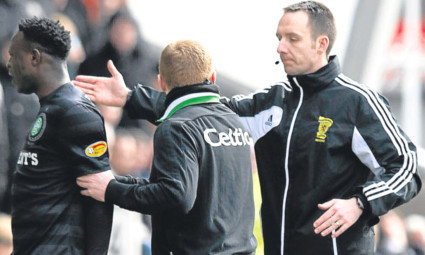
WE all know Neil Lennon is no angel, but for me, the Celtic manager’s latest SFA citation is a bit of a joke.
Admittedly, the language he used against Jim Goodwin at St Mirren Park last Sunday was sturdy, even industrial.
But that’s fairly standard on football pitches. In fact, I’ve heard much worse.
For him to be pulled up on those grounds, in my opinion, isn’t as simple as it seems.
Think about it. It was a game in which referee Bobby Madden made numerous shocking decisions.
Lenny, being the guy that he is, pointed those errors out to the media after the game.
Ordinarily, the SFA wouldn’t stand for that. But in this case, the referee’s performance was so bad, they had little choice.
By citing St Mirren striker Esmael Goncalves for diving to win the penalty that levelled the scores, the SFA effectively admitted the referee got key decisions wrong.
Having done so, it would have been completely hypocritical of them to haul Neil Lennon before their Disciplinary Committee for saying so.
But I think they felt he couldn’t go unpunished. They just needed a reason.
Conveniently, the TV microphones picked up Neil’s outburst at Goodwin, and that was that.
The actual rule the SFA say was breached is number 203, which penalises for, “Failing to behave in a responsible manner as an occupant of the technical area by repeated use of offensive, insulting and abusive language.”
But given that the extent of the evidence against Lenny is a single sentence picked up by a TV microphone I’d say he’s got a decent chance of defending himself.
Repeated use? That’s easily arguable. Insulting? Perhaps not so much.
Abusive? Under the circumstances, that’s contestable. Why? Because football has a unique code of honour.
If you stopped someone in the street and called them what Neil Lennon called Jim Goodwin, it would be abusive.
If it happens on a football pitch, it’s easily construed as banter and the fact that Goodwin took it in good spirits shows that to be true.
To the St Mirren man’s credit, he was even honest enough to respond by admitting he was glad the TV microphones didn’t pick up his reply for fear that he too would fall foul of the SFA!
For me, if the man on the receiving end was able to respond in good humour, I don’t see why the SFA couldn’t have done the same.

Enjoy the convenience of having The Sunday Post delivered as a digital ePaper straight to your smartphone, tablet or computer.
Subscribe for only £5.49 a month and enjoy all the benefits of the printed paper as a digital replica.
Subscribe